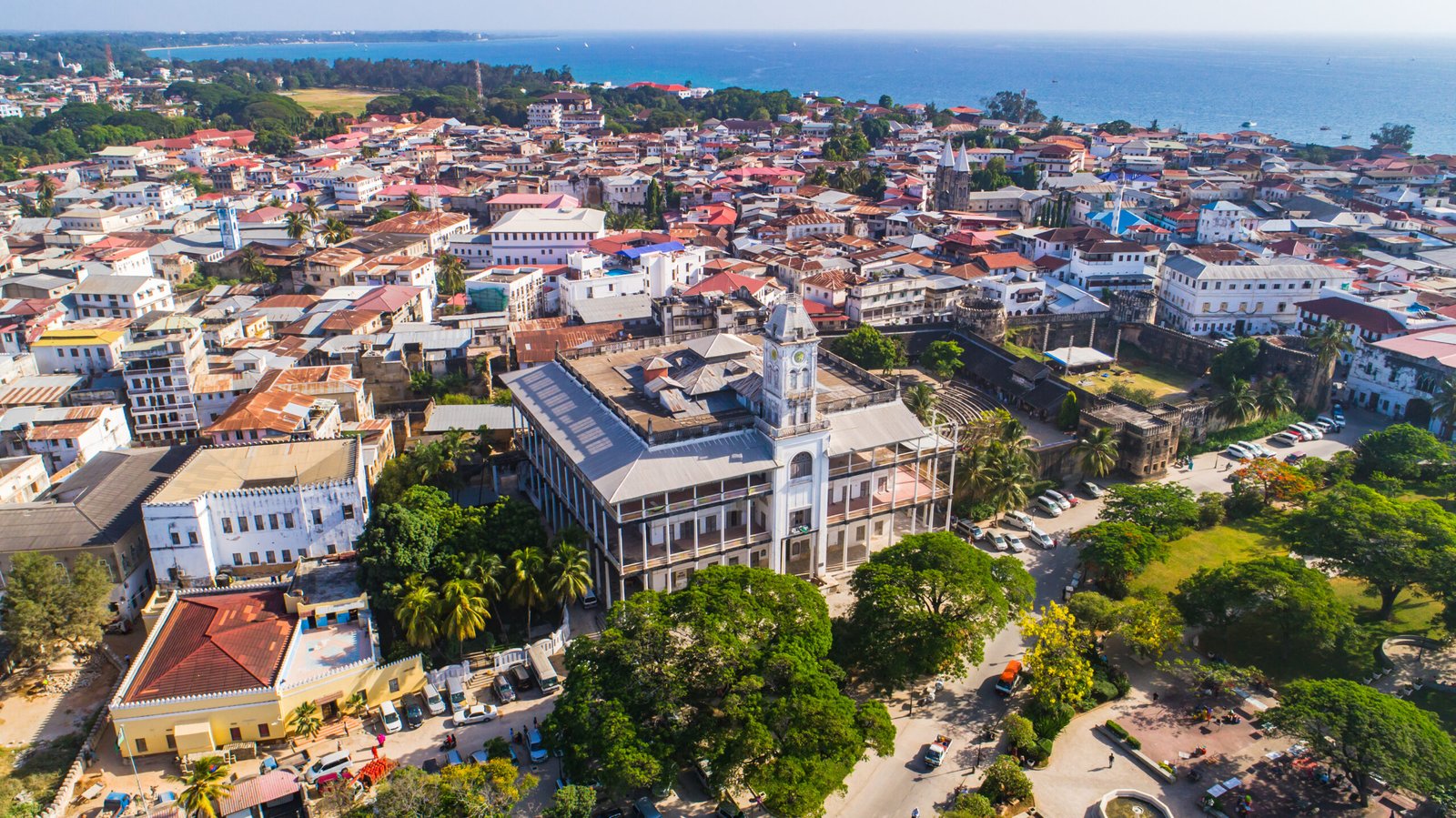Table of Contents
Stone Town is the old center of Zanzibar, a place where it feels like time has stopped. It’s full of life, with a mix of different cultures and beautiful old buildings. As a UNESCO World Heritage site, Stone Town takes you on a journey through hundreds of years of trade, culture, and changing architecture. Walking through its narrow streets, you’ll see signs of old trade routes, smell spices from busy markets, and feel the lively spirit of Swahili life and culture. This article looks at Stone Town’s amazing history, its unique buildings, the traditions that are still alive today, and the challenges and efforts to protect this special place for the future.
1. Historical Overview: The Origins and Evolution of Stone Town
Stone Town’s story begins over a thousand years ago, when it emerged as a crucial port in the Indian Ocean trade network. Originally inhabited by Swahili settlers, the town soon became a melting pot of cultures as traders from Arabia, Persia, India, and even China began to visit its shores. Each culture left its imprint on the town’s social fabric, language, and traditions. The resulting amalgamation is evident in the town’s architecture, where Islamic influences blend seamlessly with local design elements.
During the medieval period, Stone Town was a thriving center of commerce, largely due to its strategic position along the spice routes. Spices such as cloves, nutmeg, and cinnamon were traded here, enriching the local economy and drawing the attention of powerful empires. The Omani Sultanate, recognizing the town’s significance, established a strong presence in the 17th century, ushering in an era of relative stability and prosperity. Under Omani rule, Stone Town evolved further, with grand palaces and elaborate mosques being constructed, and the introduction of strict urban planning regulations that helped preserve its distinct layout.
The colonial era brought additional layers of complexity. European influences merged with the established cultural norms, yet the town retained its unique identity. Despite facing challenges like slavery, shifting trade dynamics, and modern economic pressures, Stone Town has managed to preserve its historical charm. Today, its storied past is not only celebrated by locals but also studied by historians and admired by travelers seeking to understand the crossroads of culture and commerce that defined the Indian Ocean world.
2. Architectural Splendor: A Fusion of Cultures and Styles
Stone Town’s architecture is a living testament to centuries of cultural fusion. Its narrow, winding alleys and intricately carved wooden doors invite visitors into a world where every structure tells a story. The town’s buildings are an eclectic mix of Arab, Persian, Indian, and European influences, each contributing unique elements that combine to form a distinctive Swahili style.
One of the most striking features of Stone Town is its ornate carved doors. These doors, often painted in bold colors and decorated with geometric patterns, serve as much more than mere entryways. They symbolize status, heritage, and the artistry of local craftsmen. Many of these doors have been passed down through generations, preserving stories of families and their historical legacies. The craftsmanship evident in every detail reflects a rich tradition of woodworking and decorative art that has been refined over centuries.
The architecture in Stone Town is not solely about aesthetics; it also speaks to the practicalities of life in a coastal trading hub. The narrow streets, for example, were designed to maximize shade and provide natural cooling in a tropical climate. Courtyards and wind towers are strategically integrated into homes to facilitate ventilation and create cool micro-environments. The layout of the town itself, with its maze-like streets and closely clustered buildings, was originally intended to provide both security and community, fostering a sense of belonging among its residents.
Religious buildings also play a central role in Stone Town’s architectural landscape. Majestic mosques with graceful minarets and intricate mihrabs stand alongside historic churches and small shrines, each representing different facets of the town’s diverse spiritual heritage. These sacred spaces not only serve as places of worship but also as community centers where traditions and local knowledge are passed down. In every stone and every carved motif, the architecture of Stone Town tells a tale of cultural synthesis, resilience, and artistic excellence.
3. Traditions, Festivals, and the Local Way of Life
Beyond its physical beauty, Stone Town is renowned for its rich cultural heritage—a living tapestry woven from the threads of history, tradition, and modern-day resilience. The daily rhythm of life here is marked by traditions that have been handed down through generations, creating a sense of continuity amid change.
At the heart of Stone Town’s culture is its deep connection to the Swahili language and its oral traditions. Storytelling, poetry, and music are integral parts of community life, with elders recounting legends of ancient trade routes, heroic journeys, and mythical encounters. These oral histories are not only a means of entertainment but also serve as vital records of the town’s past, preserving knowledge that might otherwise be lost to time.
Local festivals and celebrations are another cornerstone of life in Stone Town. Events such as the Zanzibar International Film Festival, the Sauti za Busara music festival, and traditional Swahili ceremonies bring the community together and showcase the vibrant arts scene that thrives within the town. These festivals provide a platform for local musicians, artists, and performers to share their talents with a global audience, while also reinforcing the cultural identity that has sustained the town through centuries of change.
The culinary traditions of Stone Town also reflect its diverse cultural heritage. Influences from Arab, Indian, and African cuisines converge to create a unique culinary landscape. The aroma of freshly baked Zanzibari bread, spiced rice, and grilled seafood fills the air in local eateries and bustling street markets. Dining in Stone Town is more than just a meal; it is an immersive experience that connects locals and visitors alike through shared flavors and traditions.
Every corner of Stone Town—from its bustling bazaars to its quiet courtyards—exudes a palpable sense of history and cultural pride. The residents, many of whom have lived in the town for generations, continue to celebrate their heritage while adapting to the demands of modern life. Their resilience in maintaining traditional practices amid rapid change is a testament to the enduring spirit of Stone Town, making it not just a place to visit, but a cultural experience to be cherished.
4. The Spice Trade and Global Exchange: Economic Roots and Modern Revival
Stone Town’s legacy as a bustling center of trade is inextricably linked to the spice trade, which once brought wealth, prosperity, and global recognition to the island of Zanzibar. The trade of spices such as cloves, nutmeg, cinnamon, and black pepper was instrumental in shaping the economic and cultural landscape of Stone Town. This vibrant trade network connected Zanzibar to markets in the Middle East, India, and Europe, fostering a climate of innovation and cultural exchange that endures to this day.
Historically, the spice trade transformed Zanzibar into one of the world’s most important trading hubs. The port of Stone Town became a gateway for merchants and adventurers, whose interactions led to a fusion of ideas, traditions, and technologies. The influx of traders and their goods not only boosted the local economy but also influenced the town’s architecture, cuisine, and social customs. The spices, prized for their flavor and medicinal properties, became synonymous with the island’s identity, leaving an indelible mark on its history.
In modern times, the spice trade continues to play a significant role in Zanzibar’s economy, though its dynamics have evolved. Today, visitors to Stone Town can explore spice farms and markets, where the legacy of the past is palpable in the vibrant colors and intoxicating aromas of freshly harvested spices. These experiences offer a unique opportunity to trace the footsteps of ancient traders, providing insights into how the global spice trade shaped not only the region’s economy but also its cultural identity.
Moreover, the modern revival of the spice industry in Zanzibar has sparked interest in sustainable agriculture and eco-tourism. Local farmers and entrepreneurs are reintroducing traditional cultivation techniques alongside modern practices, ensuring that the production of spices remains both profitable and environmentally friendly. This blend of old and new is central to Stone Town’s ongoing narrative, where economic development is harmonized with cultural preservation.
The story of the spice trade is interwoven with the very fabric of Stone Town. It represents a chapter in the town’s long history of global exchange and adaptation—a history that continues to influence the modern-day experiences of locals and visitors alike. As you explore Stone Town, the legacy of the spice trade offers a flavorful reminder of how commerce and culture can come together to create a living heritage that transcends time.
5. Key Attractions and Landmarks: A Guide to Stone Town’s Must-See Sights
Stone Town is a treasure trove of historical landmarks and cultural attractions, each offering a window into the island’s rich past and vibrant present. From imposing forts and grand palaces to serene mosques and bustling markets, the town is a living museum of Swahili heritage and architectural ingenuity.
The House of Wonders (Beit-al-Ajaib)
One of Stone Town’s most iconic landmarks, the House of Wonders stands as a symbol of Zanzibar’s innovative past. Originally built in the late 19th century, this grand edifice served as a palace for the Sultan and later became a museum showcasing artifacts that chronicle the island’s history. Its impressive façade, with intricate details and towering columns, is a testament to the artistic and architectural prowess of the era.
The Old Fort (Ngome Kongwe)
Another must-see landmark is the Old Fort, which dates back to the 17th century. Originally constructed by the Omanis to defend the town against invaders, the fort has since been repurposed as a cultural center and venue for local events.

Its ancient walls and spacious courtyards invite visitors to explore its storied past while enjoying contemporary performances and art exhibitions that bring history to life.
The Sultan’s Palace (Beit el-Sahel)
The Sultan’s Palace offers a glimpse into the opulent lifestyle of Zanzibar’s ruling elite. This historic building, with its ornate decorations and carefully preserved interiors, provides insights into the political and cultural dynamics that shaped Stone Town’s development. Visitors can wander through lush gardens and elaborately furnished rooms, imagining the regal ceremonies and important meetings that once took place within its walls.
Forodhani Gardens and the Waterfront
The vibrant Forodhani Gardens, located along the waterfront, serve as a gathering place for both locals and visitors. In the evenings, the gardens transform into a bustling food market where the scents of freshly grilled seafood and local delicacies fill the air. This lively venue encapsulates the modern spirit of Stone Town, where tradition and contemporary life merge seamlessly.
Other Notable Landmarks
Stone Town is also home to a number of smaller, yet equally fascinating sites, including ancient mosques, charming bazaars, and hidden courtyards that speak to the town’s layered history. Each alley and corner holds secrets waiting to be discovered by those willing to explore its depths.
Together, these landmarks offer a comprehensive portrait of Stone Town—an urban tapestry where history, art, and culture are woven into every stone. Whether you’re a history buff, an architecture enthusiast, or simply a curious traveler, the attractions of Stone Town promise a journey that is as enriching as it is unforgettable.
6. Local Markets, Cuisine, and the Daily Pulse of Stone Town
The soul of Stone Town lies not only in its historic buildings and ancient alleyways but also in the vibrant daily life of its residents. The bustling markets, aromatic street food, and friendly faces are what truly bring the town to life, offering a sensory experience that captivates visitors from the moment they arrive.

The Bustling Markets and Bazaars
The markets of Stone Town are a feast for the senses. Here, vendors display an array of goods—from vibrant textiles and handcrafted jewelry to fragrant spices and fresh produce. Walking through these markets, one can witness the dynamic interplay between tradition and commerce. The sounds of lively haggling, the rich aromas of exotic spices, and the kaleidoscope of colors create an atmosphere that is both chaotic and enchanting. Each stall tells a story of local craftsmanship and entrepreneurial spirit, and a conversation with a market vendor often reveals insights into the history and culture of the town.
A Culinary Journey Through Stone Town
The cuisine of Stone Town is as diverse as its history. Local dishes are infused with influences from Arab, Indian, and African culinary traditions, resulting in a unique fusion of flavors. Traditional favorites such as Zanzibari biryani, freshly caught seafood, and spicy pilau are commonly found in small eateries and street food stalls. For many, sampling the local food is an essential part of the Stone Town experience—one that provides an authentic taste of Zanzibar’s rich cultural heritage. The evening food market at Forodhani Gardens is particularly popular, as it transforms into a culinary festival where locals and tourists alike gather to savor the best of Zanzibari street food.
Everyday Life and Community Spirit
Beyond the markets and food, the daily rhythm of life in Stone Town is characterized by strong community bonds and a deep respect for tradition. Residents often gather in communal spaces to share stories, celebrate special occasions, or simply enjoy the pleasant coastal weather. This sense of community is palpable in every corner of the town and plays a crucial role in preserving the cultural identity of Stone Town. Local artisans continue to practice age-old crafts, and traditional music and dance remain integral to social gatherings, keeping the heritage alive for future generations.
For visitors, immersing themselves in the local scene offers an unparalleled window into the heart of Stone Town—a place where history, culture, and daily life intertwine to create an experience that is both enriching and memorable.
7. Challenges, Preservation, and the Future of Stone Town
Despite its rich cultural legacy and undeniable charm, Stone Town faces numerous challenges in the modern era. Rapid urbanization, tourism pressures, and environmental concerns threaten to alter the delicate balance that has preserved the town’s unique character for centuries. Local authorities, international organizations, and community leaders are working together to address these issues, striving to ensure that Stone Town remains a living heritage site for generations to come.
Modernization Versus Preservation
One of the primary challenges is the tension between modernization and the need to preserve historical integrity. As tourism continues to grow, there is a constant pressure to modernize infrastructure, which can sometimes lead to the loss of traditional architectural features and urban layouts. Efforts are underway to implement sustainable development practices that balance the needs of residents and visitors with the imperative of heritage conservation. Regulatory frameworks, often supported by UNESCO and other cultural organizations, aim to protect the historic fabric of the town while allowing for thoughtful improvements in public services and facilities.
Environmental and Socioeconomic Pressures
Environmental concerns, including coastal erosion and climate change, also pose significant risks to Stone Town. Rising sea levels and extreme weather events threaten both the built environment and the natural surroundings of the town. Additionally, socioeconomic challenges such as unemployment and poverty can lead to unsustainable practices that further endanger the cultural heritage. Local initiatives are increasingly focusing on eco-friendly tourism and community-based projects that empower residents to safeguard their environment and cultural legacy.
Community-Led Initiatives and Global Partnerships
In response to these challenges, community-led initiatives have emerged as beacons of hope. Local organizations, artisans, and cultural groups are collaborating with governmental bodies and international agencies to restore and maintain historic buildings, promote sustainable tourism practices, and ensure that the voices of the residents are heard in policy-making processes. Workshops, training programs, and cultural festivals not only celebrate the town’s heritage but also educate both locals and visitors on the importance of conservation.
Looking forward, the future of Stone Town hinges on a collective commitment to preserving its cultural and architectural treasures while embracing the opportunities of the modern era. By integrating traditional knowledge with innovative conservation methods, Stone Town can continue to be a source of inspiration—a living, breathing testament to the resilience and creativity of its people.
8. Conclusion
Stone Town is much more than a destination; it is a cultural and architectural masterpiece that encapsulates the history, art, and soul of Zanzibar. From its ancient alleys and ornately carved doors to the vibrant markets and enduring traditions, the town stands as a testament to centuries of global exchange and human ingenuity. As efforts to preserve this unique heritage intensify, Stone Town remains a living symbol of the past meeting the present—a place where every stone tells a story, and every visitor leaves with memories that last a lifetime.
For travelers and history enthusiasts alike, discovering Stone Town is an invitation to step into a world where culture, architecture, and community converge in a spectacular celebration of life. Whether you’re wandering its narrow streets or savoring its culinary delights, Stone Town promises an experience that is as enriching as it is unforgettable.
In embracing its rich history while navigating the challenges of modernity, Stone Town continues to shine as one of Zanzibar’s most treasured gems—a timeless masterpiece that invites exploration, reflection, and a deep appreciation for the culture of East Africa.




